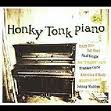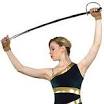LOU BUSCH
 Louis Bush was born and raised in Louisville during the ragtime era and the jazz age. The family name was Bush, but he later added the "c" largely for the uniqueness. Blessed with an inherent music talent, he was already leading a ragtime and jazz band Lou Bush and His Tickle Toe Four, by the time he was 12 years old.
Louis Bush was born and raised in Louisville during the ragtime era and the jazz age. The family name was Bush, but he later added the "c" largely for the uniqueness. Blessed with an inherent music talent, he was already leading a ragtime and jazz band Lou Bush and His Tickle Toe Four, by the time he was 12 years old.
At 16, he left school and home for a career as a professional musician, playing with the likes of "Hot Lips" Henry Busse, Clyde McCoy and George Olson.
After a few years on the road, his desire to learn more about music theory led him to study at the Cincinnati Music Conservatory in Ohio in the early 1930s.
Following his music education break, Busch became the pianist for Hal Kemp's "sweet music" band for the remainder of the 1930s. Lou also honed his arranging skills, being offered an arranging position when arranger John Scott Trotter left the band in 1936. This position was shared with another key arranger, Hal Mooney, and was invaluable experience for both of them. After Kemp died in a car crash in 1940 and the group disbanded, Busch and Mooney made their way to California to work as studio musicians and whatever gigs they could find. This was interrupted by World War II, where Lou spent three years in the Army.
 After his tour of duty, Busch decided to dive back into the music business. It was around this time that singer-songwriter Johnny Mercer was recruiting artists and employees for his recently formed label, Capitol Records, so Busch was hired for the radio transcription service in 1946. He was in charge of production of promotional radio shows featuring Capitol artists for distribution to stations around the country.
After his tour of duty, Busch decided to dive back into the music business. It was around this time that singer-songwriter Johnny Mercer was recruiting artists and employees for his recently formed label, Capitol Records, so Busch was hired for the radio transcription service in 1946. He was in charge of production of promotional radio shows featuring Capitol artists for distribution to stations around the country.
By 1949 he had been promoted to A&R (Artist and repertoire) man. During this time, he also served as a pianist for studio groups, backing singers such as Peggy Lee, "Tennessee" Ernie Ford and Jo Stafford. Busch was married for a number of years to actress Janet Blair. After their divorce, he married singer Margaret Whiting, and they had a daughter, Debbi. She was the only child either of them ever had.
One summer, Busch backed singer Jo Stafford and conductor Paul Weston on the hit record Ragtime Cowboy Joe. The success encouraged both him and the label to release his own original single, Ivory Rag, early in 1950. It was the first piece incorporated into the Crazy Otto Medley by German pianist Fritz Schulz-Reichel, which was later associated with Johnny Maddox in the U.S.
Busch decided to produce some records, and recorded pieces by himself, Ray Turner and Marvin Ash for Honky Tonk Piano, released in late 1950. The Honky-Tonk reference, more often identified as a Country Music term, is likely in conjunction with the type of "joint" in which the music was played, but the sound of the piano might also apply, as they sometimes used hardened hammers or detuning to alter the tone. However, instead of just piano, Busch and company followed the lead of the traditional jazz revivalists of the late 1940s and added percussion and bass.
Taking on the personality of Joe "Fingers" Carr, Busch released a succession of ragtime albums and singles throughout the 1950s that remained popular well into the mid 1960s. Capitol pushed the nostalgic Carr image with the derby and the cigar more so than Busch. It was during that period, 1962, he formed Burning Bush Music ASCAP.
His biggest hits from the 1950s include Portuguese Washerwomen, Sam's Song, a cover of Del Wood's version of Down Yonder, and the international hit Zambezi. Some of the singles include his vocal backup group, the cleverly-named The Carr Hopps. Often overlooked are several mainstream and jazz sides he recorded as Lou Busch, featuring exciting band or orchestral arrangements.

One Busch collaboration with Milton DeLugg, Rollercoaster, became the closing theme of the TV panel show What's My Line? for the entirety of its original network run, from 1950 to 1967.
Busch eventually left Capitol for Warner Bros. Records where he took on the same general responsibilities. Busch returned to arranging and conducting responsibilities again, one of the most notable being the musical force behind comic singer Allan Sherman. A few later albums were released on the ragtime-centric DOT label, and in the late 1970s he produced one more effort with friend and jazz pianist Lincoln Mayorga, complete with a couple of new tunes, The Brinkerhoff Piano Company.
Busch never fully retired from music, and married a third time to Nita Archambeau, a music clearance specialist. They were both good friends of Capitol artist Stan Kenton and his wife, Audrey.
In the late 1970s, Busch did some live performances with Mayorga and others in Southern California. He died in Camarillo, California on September 19, 1979, as a result of injuries sustained in an automobile crash. He was interred in the Westwood Village Mortuary near UCLA.
Available as midi, .pdf, sheet music, recorded on cd or tape
The midi file on the server is cut to about one third it's
real length.
To order the full midi or the sheet music click here

1a. mp3
Sabre Dance Boogie piano solo (recorded using my synths)

2. midi
Sabre Dance Boogie midi orchestrated (your sound card)

On one occasion I created background tracks for a violinist who wanted
to play this song. The cd I mailed contained the original tracks + the background tracks and .pdf files of the piano sheet music. The next link
demonstrates the background. Perhaps you would like to play along.
3. mp3
Sabre Dance Boogie orchestrated accompaniment (my synths)
4. mp3
Sabre Dance Boogie a different accompaniment (my synths)
Return To The Front Lobby or send me a note
by clicking here
 After his tour of duty, Busch decided to dive back into the music business. It was around this time that singer-songwriter Johnny Mercer was recruiting artists and employees for his recently formed label, Capitol Records, so Busch was hired for the radio transcription service in 1946. He was in charge of production of promotional radio shows featuring Capitol artists for distribution to stations around the country.
After his tour of duty, Busch decided to dive back into the music business. It was around this time that singer-songwriter Johnny Mercer was recruiting artists and employees for his recently formed label, Capitol Records, so Busch was hired for the radio transcription service in 1946. He was in charge of production of promotional radio shows featuring Capitol artists for distribution to stations around the country.
 Louis Bush was born and raised in Louisville during the ragtime era and the jazz age. The family name was Bush, but he later added the "c" largely for the uniqueness. Blessed with an inherent music talent, he was already leading a ragtime and jazz band Lou Bush and His Tickle Toe Four, by the time he was 12 years old.
Louis Bush was born and raised in Louisville during the ragtime era and the jazz age. The family name was Bush, but he later added the "c" largely for the uniqueness. Blessed with an inherent music talent, he was already leading a ragtime and jazz band Lou Bush and His Tickle Toe Four, by the time he was 12 years old.



